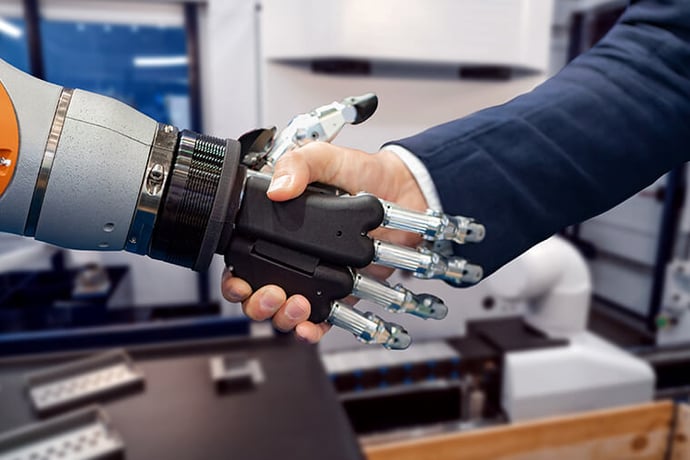5 steps to optimize business processes with RPA and AI/ML
by Shubhen Sarangi, on Dec 13, 2018 4:12:24 PM
Estimated reading time: 4 mins
The convergence of AI/ML with core RPA capabilities is driving new and accelerated streams of automation possibilities, which result in optimized processes, significantly improved business outcomes and operational efficiencies.

Robotic Process Automation (RPA) has already proven itself to be a tool of choice for establishing nimble platforms to drive digitization, both quickly and cost-efficiently. Enterprises are now looking forward to further improve efficiency, productivity, and revenue further through convergence of RPA with Artificial Intelligence (AI) and Machine Learning (ML). Where RPA automates discrete, rule-based operations, the aforementioned Cognitive technologies bring in that intelligence element to help Human-Machine-Interfaces (HMIs) scale the next level. Here are 5 steps that will help in optimizing processes and drive business results.
|
5 steps that help optimize processes and drive business results -
|
The convergence of AI/ML with RPA is helping businesses not only sustain themselves amidst business constraints but also improve at scale. However, it is to be noted that this evolution is gradual and out-of-the-box solutions are still in the process of being developed. These solutions require careful evaluation and management within the organizational context from both business and technology perspectives to provide meaningful benefits.
Challenges involved in Leveraging the Converged RPA & AI/ML Platform
- AI Technologies – Hype versus Reality: AI/ML is neither a magic wand as per the popular simplistic perception nor is it a plug-and-play technology. Enterprises need to carefully examine their readiness, available Cognitive technology options, and availability of strategic technology partners prior to adoption.
- Lack of Awareness about Executable Business Cases: RPA and AI/ML are not ends in themselves as per the popular notion. Rather they are technologies in a wider tool-kit of emerging automation tools. However, expectations from their convergence should be realistically set. The focus has to be on areas to drive productivity gains, risk reduction, business growth, and other business goals.
- Lack of Data Preparedness: While data drives RPA & AI/ML, data preparation is lacking in most cases. Industry grade performance can be expected only out of high-quality data, which helps the algorithms learn from a variety of business situations. In its absence, the Intelligent Automation exercise faces challenges.
- Talent Challenges: Usually enterprises lack the resources, who understand both RPA & AI/ML from technology as well as program perspective. The fastest resolution is to work with technology partners, who develop the solutions as per requirements and help to train internal teams to develop the skill and perspective as well as manage the hybrid solution.
- Cognitive Program Governance: High expectations about immediate outcomes are commonly faced in most automation pursuits. RPA can deliver quickly though AI/ML has a learning curve. A robust governance framework and center of excellence for automation provides a systematic approach for involving all stakeholders while focusing on the program road map and success indicators. The teams’ primary responsibility is identifying key opportunities for automation as well as cross-functional leverage.
White paper on "Optimize business processes and drive business results through the successful integration of AI/ML with RPA".
Download now >>
Optimizing Processes and Driving Results through RPA & AI/ML
- Understand RPA and Cognitive Technologies: Engage a technology enablement partner, who can connect the possibilities of Intelligent Automation to enterprise business needs.
- Develop your RPA and AI Talent Pool: Develop an in-house team of experts, who can relate to the intelligent automation program from the business and technology perspective. They can tailor the technology to the enterprise needs.
- Create an Intelligent Automation CoE: Such a team tailored to the enterprise’s context can oversee successful and results-based integration of technology capabilities, business priorities, and people & process enablement beginning with start-up, scaling-up, and steady-state management of your intelligent automation journey.
- Set Realistic but Aggressive Targets: Technology alone cannot deliver results. It is important that planning for aggressive targets takes into consideration process, people and change management issues. This is a business imperative to ensure that automation initiatives make sense to business leaders and employees alike.
- Start with RPA: It is a simpler technology that has been proven to provide business results in very short time-frames. It reduces latency and speeds up processes by almost 10x to 15x in an error-free environment. As the RPA processes become more familiar, it is simpler to visualize the growth of RPA and impact of AI and ML layers to add to the business impact that has already been delivered by RPA.
The Joint Value of the Converged Platform
The convergence brings in intelligence and self-learning aspects to process automation. The AI/ML layer works on digitized unstructured assets to parse, ingest, and assimilate information. The layer thereby helps to derive intelligence from structured text as well as unstructured text from printed documents, PDFs, videos, images, photographs, etc. It is just the matter of further coding to help the application port the data intelligently to other systems or locales after proper classification.
The AI/ML layer also imparts applications the capabilities to process multi-lingual data. It translates and summarizes the digitized assets, which can be further classified and stored – all through an automatic process.
The AI/ML layer also helps to take decisions related to numbers and difficult calculations and makes intelligent interpretations thus ensuring a completely paperless transaction. Early movers have been able to improve productivity by 30-40%, reduce costs by 60-70%, and improve processing times by over 70%. To fully realize the benefits of intelligent automation, companies need to start small with RPA and then explore the potentials of the Cognitive Technologies vis-a-vis different business scenarios.


















